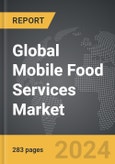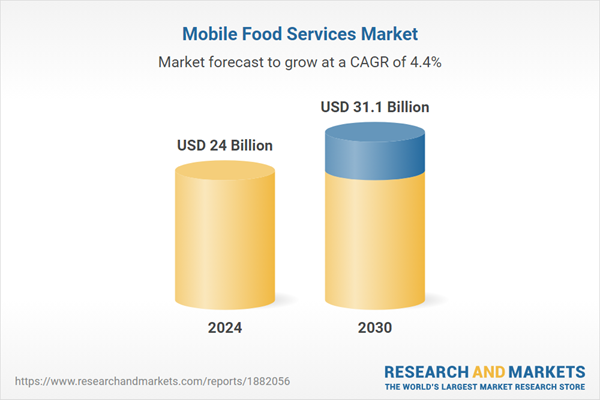Mobile Food Services - Key Trends and Drivers
Mobile food services, encompassing food trucks, carts, and trailers, have emerged as a vibrant and dynamic segment of the food and beverage industry. These mobile units offer a flexible and cost-effective alternative to traditional brick-and-mortar restaurants, allowing entrepreneurs to enter the food business with lower startup costs and the ability to reach a wide customer base. Food trucks, in particular, have surged in popularity, often serving gourmet and specialty foods, ethnic cuisine, and innovative fusion dishes that attract food enthusiasts. This trend is evident in urban centers, where food trucks frequently cluster in designated areas or 'food truck parks,' offering consumers a variety of dining options in one location. The mobility of these services allows operators to attend various events, festivals, and markets, significantly enhancing their visibility and customer reach. Additionally, the use of social media platforms and mobile apps has revolutionized how food trucks engage with customers, providing real-time updates on locations, menus, and promotions, and creating a direct and interactive channel for customer feedback and loyalty building.Several trends are currently shaping the mobile food services landscape, reflecting changes in consumer preferences and advancements in technology. One prominent trend is the increasing demand for unique and high-quality food experiences, which drives food truck operators to continually innovate their offerings. Consumers are seeking out food trucks that offer distinctive culinary experiences, such as artisanal and gourmet foods, which are often perceived as more authentic and crafted with greater care compared to mainstream fast food options. There is also a growing emphasis on health and sustainability, with many mobile food services incorporating organic, locally sourced, and plant-based ingredients into their menus. Technological advancements, such as mobile payment systems and digital ordering platforms, are enhancing the efficiency and customer convenience of mobile food operations. For example, customers can now use apps to locate food trucks, view menus, place orders, and pay digitally, reducing wait times and streamlining the purchasing process. Moreover, the trend towards urbanization and the rise of food-centric social gatherings have further fueled the popularity of mobile food services, making them a staple in urban food culture and a key feature in city planning and community events.
The growth in the mobile food services market is driven by several factors. Technological advancements in food preparation and preservation equipment are enabling mobile food units to offer a wider variety of menu items while maintaining high standards of food safety and quality. The increasing consumer preference for convenient and diverse dining options is boosting demand for mobile food services. People are looking for quick, easy, and unique dining experiences, which food trucks are well-positioned to provide. The proliferation of festivals, outdoor events, and corporate catering opportunities is providing new revenue streams for mobile food operators. These events attract large crowds, offering significant business opportunities for mobile food services to reach new customers and generate substantial sales. Social media and digital marketing play a crucial role in expanding customer reach and engagement, driving more traffic to mobile food units. Food trucks that effectively use social media to promote their locations, menu items, and special events can attract a loyal customer base and increase their visibility. The relatively low entry barriers and operational costs compared to traditional restaurants are attracting new entrepreneurs to the market. Setting up a food truck requires significantly less capital than opening a full-scale restaurant, making it an attractive option for culinary entrepreneurs. Furthermore, regulatory support and streamlined licensing processes in many regions are making it easier for mobile food services to operate and thrive. Municipalities are recognizing the economic and cultural benefits of mobile food services and are adjusting regulations to support their growth.
Report Scope
The report analyzes the Mobile Food Services market, presented in terms of market value. The analysis covers the key segments and geographic regions outlined below.- Segments: Product Type (Food, Beverage).
- Geographic Regions/Countries: World; United States; Canada; Japan; China; Europe (France; Germany; Italy; United Kingdom; Spain; Russia; and Rest of Europe); Asia-Pacific (Australia; India; South Korea; and Rest of Asia-Pacific); Latin America (Argentina; Brazil; Mexico; and Rest of Latin America); Middle East (Iran; Israel; Saudi Arabia; United Arab Emirates; and Rest of Middle East); and Africa.
Key Insights:
- Market Growth: Understand the significant growth trajectory of the Food Services segment, which is expected to reach US$25.0 Billion by 2030 with a CAGR of a 4.7%. The Beverage Services segment is also set to grow at 3.7% CAGR over the analysis period.
- Regional Analysis: Gain insights into the U.S. market, valued at $6.4 Billion in 2024, and China, forecasted to grow at an impressive 7.5% CAGR to reach $6.6 Billion by 2030. Discover growth trends in other key regions, including Japan, Canada, Germany, and the Asia-Pacific.
Why You Should Buy This Report:
- Detailed Market Analysis: Access a thorough analysis of the Global Mobile Food Services Market, covering all major geographic regions and market segments.
- Competitive Insights: Get an overview of the competitive landscape, including the market presence of major players across different geographies.
- Future Trends and Drivers: Understand the key trends and drivers shaping the future of the Global Mobile Food Services Market.
- Actionable Insights: Benefit from actionable insights that can help you identify new revenue opportunities and make strategic business decisions.
Key Questions Answered:
- How is the Global Mobile Food Services Market expected to evolve by 2030?
- What are the main drivers and restraints affecting the market?
- Which market segments will grow the most over the forecast period?
- How will market shares for different regions and segments change by 2030?
- Who are the leading players in the market, and what are their prospects?
Report Features:
- Comprehensive Market Data: Independent analysis of annual sales and market forecasts in US$ Million from 2024 to 2030.
- In-Depth Regional Analysis: Detailed insights into key markets, including the U.S., China, Japan, Canada, Europe, Asia-Pacific, Latin America, Middle East, and Africa.
- Company Profiles: Coverage of players such as Advanced Materials Technologies, Akron Porcelain & Plastics Co., ARC Group Worldwide, Inc., CMG Technologies, CN Innovations Holdings Ltd. and more.
- Complimentary Updates: Receive free report updates for one year to keep you informed of the latest market developments.
Some of the 57 companies featured in this Mobile Food Services market report include:
- Cousins Maine Lobster
- Katz's Delicatessen
- Kogi Korean BBQ
- Luke's Lobster
- New Bohemia Wurst + BierHaus
This edition integrates the latest global trade and economic shifts into comprehensive market analysis. Key updates include:
- Tariff and Trade Impact: Insights into global tariff negotiations across 180+ countries, with analysis of supply chain turbulence, sourcing disruptions, and geographic realignment. Special focus on 2025 as a pivotal year for trade tensions, including updated perspectives on the Trump-era tariffs.
- Adjusted Forecasts and Analytics: Revised global and regional market forecasts through 2030, incorporating tariff effects, economic uncertainty, and structural changes in globalization. Includes historical analysis from 2015 to 2023.
- Strategic Market Dynamics: Evaluation of revised market prospects, regional outlooks, and key economic indicators such as population and urbanization trends.
- Innovation & Technology Trends: Latest developments in product and process innovation, emerging technologies, and key industry drivers shaping the competitive landscape.
- Competitive Intelligence: Updated global market share estimates for 2025, competitive positioning of major players (Strong/Active/Niche/Trivial), and refined focus on leading global brands and core players.
- Expert Insight & Commentary: Strategic analysis from economists, trade experts, and domain specialists to contextualize market shifts and identify emerging opportunities.
Table of Contents
Companies Mentioned (Partial List)
A selection of companies mentioned in this report includes, but is not limited to:
- Cousins Maine Lobster
- Katz's Delicatessen
- Kogi Korean BBQ
- Luke's Lobster
- New Bohemia Wurst + BierHaus
Table Information
| Report Attribute | Details |
|---|---|
| No. of Pages | 283 |
| Published | December 2025 |
| Forecast Period | 2024 - 2030 |
| Estimated Market Value ( USD | $ 24 Billion |
| Forecasted Market Value ( USD | $ 31.1 Billion |
| Compound Annual Growth Rate | 4.4% |
| Regions Covered | Global |









